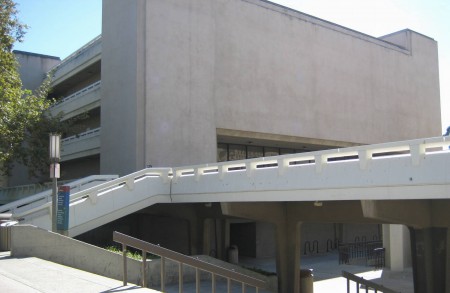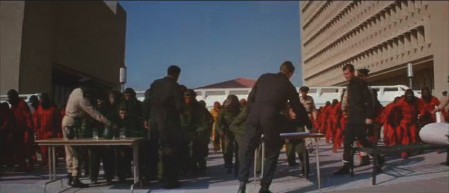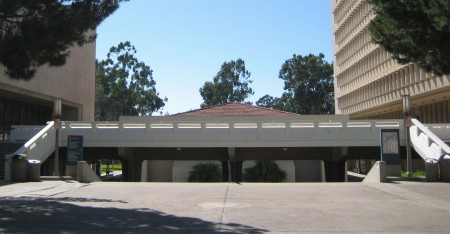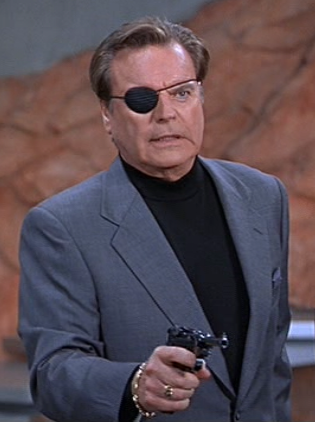Some years ago, my graduate school advisor at the University of California, Irvine, told the story of one of the oddest buildings on campus: the Social Science Laboratory. Like many of the structures at UCI, it features long horizontal lines and striking contrasts emblematic of 1960s Futurist architecture. But it’s perhaps most notable for what it lacks.
That’s right. No windows. The Social Science Lab was designed to host experiments in human behavior, and blocking the outside world provides a controlled, soundproof environment, perfect for all kinds of disturbing Milgram experiments.
The missing windows and a bold, high-tech style—at least for the 1960s—had the side-effect of attracting the attention of Hollywood movie producers. Twentieth Century Fox chose the building, together with the courtyard it shares with the Social Science Tower next door, for 1972’s Conquest of the Planet of the Apes.
(Yes, the same building where UCI scheduled many of my classes also resembles a slave training facility of the future. That’s grad school for you.)
Curious about the history of this sinister structure, I searched online and discovered that Conquest is just one of several movies featuring scenes from UCI. Russell Dalton, professor of political science, has compiled a rather comprehensive list of movies filmed on or near the campus. Although his page shows promotional posters and a few still frames, it lacks any actual video.
To fill this unfortunate gap, I’ve collected clips from the five Hollywood movies in which UCI makes an appearance. Watch them below in chronological order.
Conquest of the Planet of the Apes (1972)
The first starring role for UCI came in the fourth film of the Planet of the Apes series. The School of Social Science was transformed into a violent training center for simian slaves, and its courtyard became an ape auction block.
[flashvideo file=http://vocaro.com/trevor/blog/wp-content/uploads/2009/06/Conquest-of-the-Planet-of-the-Apes-1.mp4 width=450 height=330 /]
[flashvideo file=http://vocaro.com/trevor/blog/wp-content/uploads/2009/06/Conquest-of-the-Planet-of-the-Apes-2.mp4 width=450 height=330 /]
[flashvideo file=http://vocaro.com/trevor/blog/wp-content/uploads/2009/06/Conquest-of-the-Planet-of-the-Apes-3.mp4 width=450 height=330 /]
[flashvideo file=http://vocaro.com/trevor/blog/wp-content/uploads/2009/06/Conquest-of-the-Planet-of-the-Apes-4.mp4 width=450 height=330 /]
Besides the pure entertainment value in seeing a massive shrewdness of apes invade my alma mater, these clips are notable because they provide a rare historical snapshot of the campus when it was almost brand new. Except for the eucalyptus trees, the passing of nearly four decades has hardly changed its appearance. Even the humble lampposts have remained the same, as shown in the photographs below.
Silent Movie (1976)
A parody of the silent film genre, this Mel Brooks film is loaded with slapstick gags and celebrity cameos. Paul Newman makes an appearance during a hospital scene and is pursued—via powered wheelchair—through UCI’s Aldrich Park, the Langson Library, and into the Administration Building. Who knew it doubled as a geriatric lounge?
[flashvideo file=http://vocaro.com/trevor/blog/wp-content/uploads/2009/06/Silent-Movie.mp4 width=450 height=320 /]
Poltergeist (1982)
Today, scientific research at UCI focuses on nanotechnology, fuel cells, and mass spectrometry, but in 1982, the spotlight was on recurrent spontaneous psychokinesis. Or at least, that’s the story in the movie Poltergeist, in which a father seeks the help of parapsychologists from UC Irvine to explain the disembodied voices and floating toys that are haunting his house. In one scene, the researchers hold a meeting at their lab, but an exterior shot reveals it is actually the Langson Library.
[flashvideo file=http://vocaro.com/trevor/blog/wp-content/uploads/2009/06/poltergeist-uc-irvine-scene.mp4 width=450 height=280 /]
Creator (1985)
Rival biology professors take out their frustrations in a friendly game of tackle football, right in the middle of Aldrich Park. Familiar paths and buildings are clearly visible in the background.
[flashvideo file=http://vocaro.com/trevor/blog/wp-content/uploads/2009/06/Creator-1.mp4 width=450 height=360 /]
[flashvideo file=http://vocaro.com/trevor/blog/wp-content/uploads/2009/06/Creator-2.mp4 width=450 height=360 /]
Ocean’s Eleven (2001)
The architecture at UCI continues to attract movie producers even in the 21st century. In 2001, Warner Bros. selected the Gillespie Neuroscience Research Facility for a scene in Ocean’s Eleven. It may have been chosen because, like many of the newer buildings on campus, it shuns the Futurist style in favor of a cleaner, postmodern look. At least, it was clean until Matt Damon smashed one of its windows.
[flashvideo file=http://vocaro.com/trevor/blog/wp-content/uploads/2009/06/Oceans-Eleven.mp4 width=450 height=270 /]




